Liverpool Hut is a cute alpine hut in Mt Aspiring National Park, nestled on top of the treeline with amazing views of Tititea / Mt Aspiring and over the Matuktuki Valley. I’ll be completely honest; this wasn’t the smartest trip for my first solo hike. But wow was it an amazing adventure full of lessons.
Length: 15 km one-way with 700 m elevation gain
Time taken: 5 – 7 hours one-way
Difficulty: Easy for the first 3-4 hours, then difficult for the last 2-3
Facilities: There are long-drop toilets with running (non-potable) water at the trailhead; Raspberry Creek carpark. Aspiring Hut two hours into the trip also has water, toilets and shelter. Liverpool Hut is a 10-bunk bed hut with a long-drop toilet and tank water (but no heating). Bookings are required for both huts in the summer season (December – April). But they act on a first-come, first-served basis over winter.
– Know before you go: The track to Liverpool Hut is classified by DOC as an Advanced Tramping Track . You should avoid this trip if you are not an experienced tramper, and definitely not tackle it in poor weather conditions. –
Why choose Liverpool Hut?
Liverpool Hut had been on my to-do list for a while. I’d already hiked up to French Ridge Hut, which sits directly across the valley from Liverpool Hut, with my Dad two years ago. From French Ridge Hut, we’d looked across the valley at the little red alpine hut and I’d thought, one day I’ll be there, staring back.
So this year for my birthday I booked out the entire hut, got a group of friends together … and then had to pull the pin as the weather forecast was pretty dire.
But I still had a burning desire to visit Liverpool Hut. And on top of this winter was fast approaching. I knew my trips above the treeline were soon going to be limited. We had one last sunny weekend forecast before winter really got its icy claws into us. It was a go!
Why choose to hike solo?
But my only problem? None of my usual tramping buddies were free. And on top of that my husband Matt had injured his foot and wasn’t up to an overnight hike. It was too last minute to invite anyone else. And in any case I wasn’t sure I wanted to take someone I hadn’t hiked with before on this type of tramp, especially at the end of autumn / start of winter.
But I still really wanted to go. The weather forecast was looking perfect. I probably could have been fitter (but when has that ever not been true?). I’d never hiked solo for more than just a day trip before, but you’ve got to start somewhere right? So I decided to take the leap and do my first solo overnight hike.
Once I made the decision to go by myself, I started to get pretty excited. This was a type of challenge I’d never set myself before. I had a fair bit of experience organising tramps, and being the default leader, so I didn’t feel like any of the logistics would be drastically more challenging. But the tramp itself might be. Relying only on myself for food, fitness, route-finding, company, safety. I was keen to see whether I’d love being by myself for an overnight trip, or hate it.

How to get to the trailhead for Liverpool Hut
Raspberry Creek carpark is the trailhead for many hikes including French Ridge Hut, Rob Roy Glacier, and Liverpool Hut. In summer it can therefore be really busy, but there were only a few cars when I arrived early on a frosty morning in May.
The carpark is just over an hour’s drive from Wanaka, on a mixture of sealed and gravel roads. Take the Wanaka – Mt Aspiring Road towards Treble Cone ski-field. Once past the ski-field turn-off the road turns to gravel with numerous unbridged fords. In summer, 2WD vehicles can normally cross these without too much hassle (as long as it hasn’t been raining). But later in the year you’d probably be safer taking a 4WD. Matt and I had just bought a SUV with AWD, so I was excited to give it a test (it passed with flying colours).

If you’re looking for hikes near Mt Aspiring National Park and Wanaka, check out these trips:
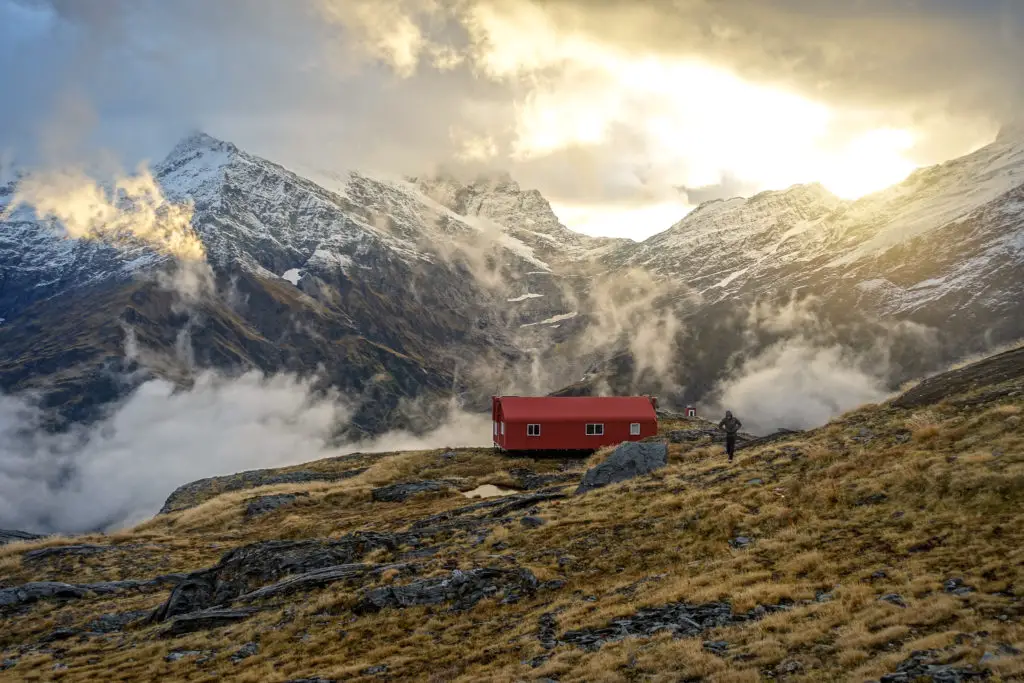
A beautifully situated red alpine hut, and a majestic long-drop with views over the surrounding mountains and glaciers, is the reward for this steep climb up the side of the Matukituki Valley.

Roys Peak may be one of the most popular hikes in the country, with beautiful views over Lake Wanaka and the surrounding mountains, including Mt Aspiring.
Liverpool Hut: Day 1
Raspberry Creek – Aspiring Hut
I’ve already described this part of the trip over on my French Ridge Hut blog post, so I’ll keep this brief. Plus because I was going solo this time, I filmed a lot of hike and saved the videos to my Instagram stories. You can check them out here if you prefer more visual content.
I set off from the Raspberry Creek carpark with the sun still rising behind me, and the ground frozen white. Nobody else was around, apart from the cows. It was lovely walking at my own pace, in silence and taking in the world that was slowly waking up around me as the sun rose over the mountains. I could stop for photos and snacks whenever I wanted! Glorious.
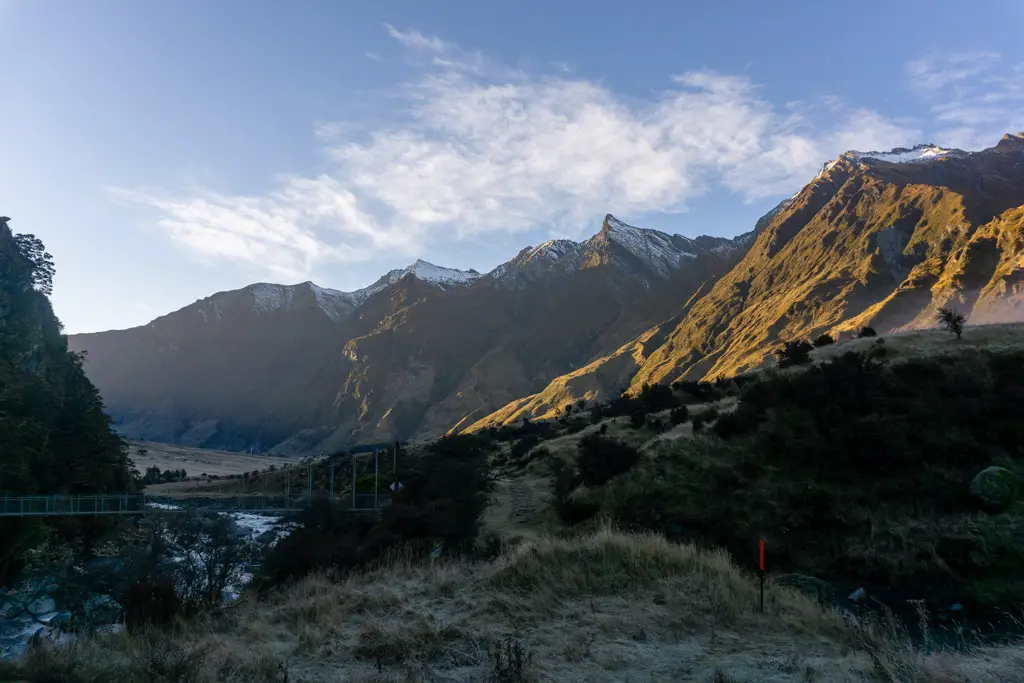
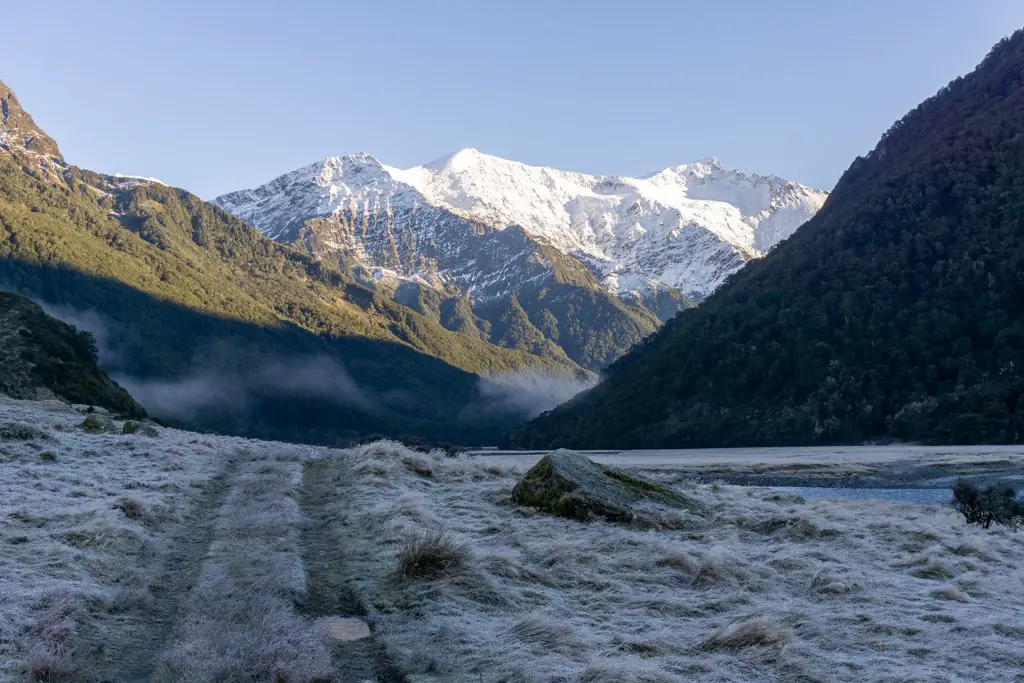
It’s an easy two hours’ walk along the 4WD track to Aspiring Hut, past the turn-offs for Rob Roy Glacier, Shotover Saddle, and Cascade Saddle. I didn’t really take any breaks until I reached Aspiring Hut (where I ate half of my lunch, even though it was only 10am). It was odd travelling over ground that Dad and I had walked just over two years ago on the way to French Ridge Hut. Back then it had been pouring with rain and the ground was absolutely saturated. This time the ground was frozen solid and the sun was shining.
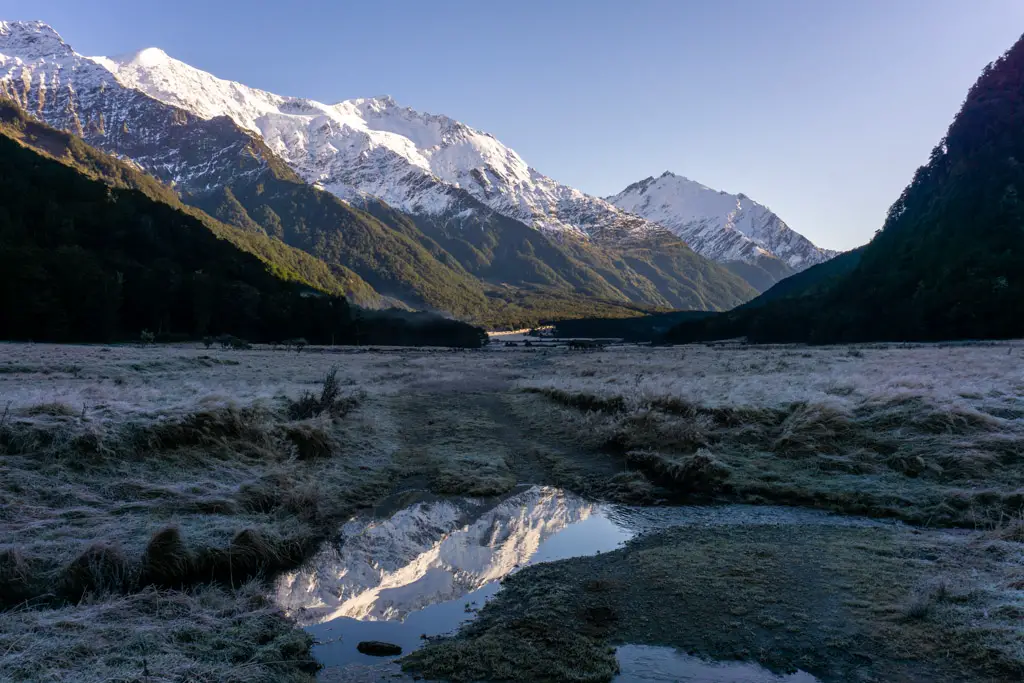
Aspiring Hut
Just before Aspiring Hut, I met my first group of people for the day – three men leaving Aspiring Hut to travel back to the carpark. I wondered how many other humans I might see that day. (Turns out I shouldn’t have worried, there were plenty).
At Aspiring Hut I met a lovely lady also going solo. She’d wanted to go up to Liverpool or French Ridge as well, but been put off by the lack of fire/heating – so stayed down in the valley doing day trips. We looked out the window, soaking in the view and tried to determine which ridge I’d be climbing up later in the day. Aspiring Hut really does have the best outlook over the mountains; a perfect hut for families. I ate some early lunch, used the facilities, and then it was time to set off again.
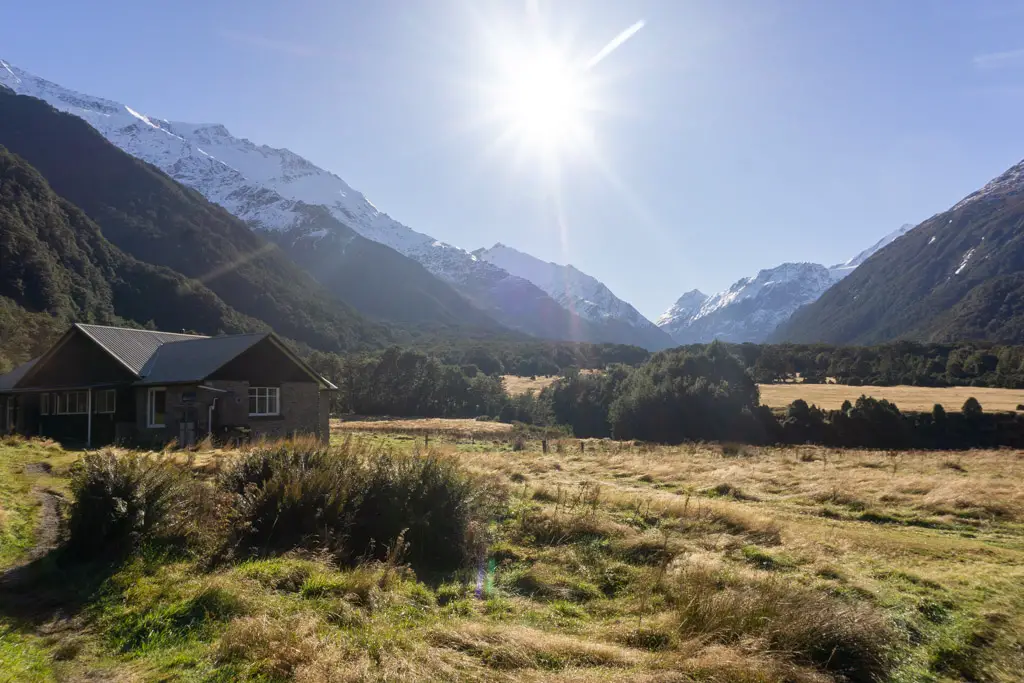
Aspiring Hut – Pearl Flat
The next part of the tramp was much more interesting! The track entered beautiful native forest, crossing Cascade Creek and Rough Creek on rickety swing-bridges. Surrounded by quiet forest, I suddenly felt much more alone. But instead of worrying, I relished the solitude. No-one to worry about but myself!
I reached Shovel Flat (named after an old gold mining shovel that was left stuck in a tree trunk) relatively quickly, and took a break at the top of the clearing – looking out over the river flats towards Liverpool and French Ridge Huts. I still couldn’t decide quite which ridge I’d be climbing up, but I could see French Ridge clear as day. The last time I’d visited this area, French Ridge had thankfully been hidden by clouds, so I couldn’t see how high I’d be climbing. I was very glad Liverpool Hut on the other side of the valley was several hundred metres lower in elevation – my memories of the climb up French Ridge were fresh in my mind.
The sun was well and truly up by this stage, so I meandered my way down through the golden tussocks as the golden sunlight warmed my bones. I crossed over the bridged stream (un-named) and before I knew it I was back in the forest and then crossing the swing bridge over Liverpool Stream. The bridge was filled with frozen puddles. I had to carefully make my way across to avoid my feet slipping and sliding through the wire rope sides.

Immediately after the swing bridge was the fork in the track. To the left was new, unexplored territory – Liverpool Hut. Whereas forward along the track as well as to the right across the river were the routes I’d taken two years earlier. I looked at the DOC sign – two hours climb to Liverpool Hut. The first four hours had been easy. The next two would definitely not be. But I could do this right?
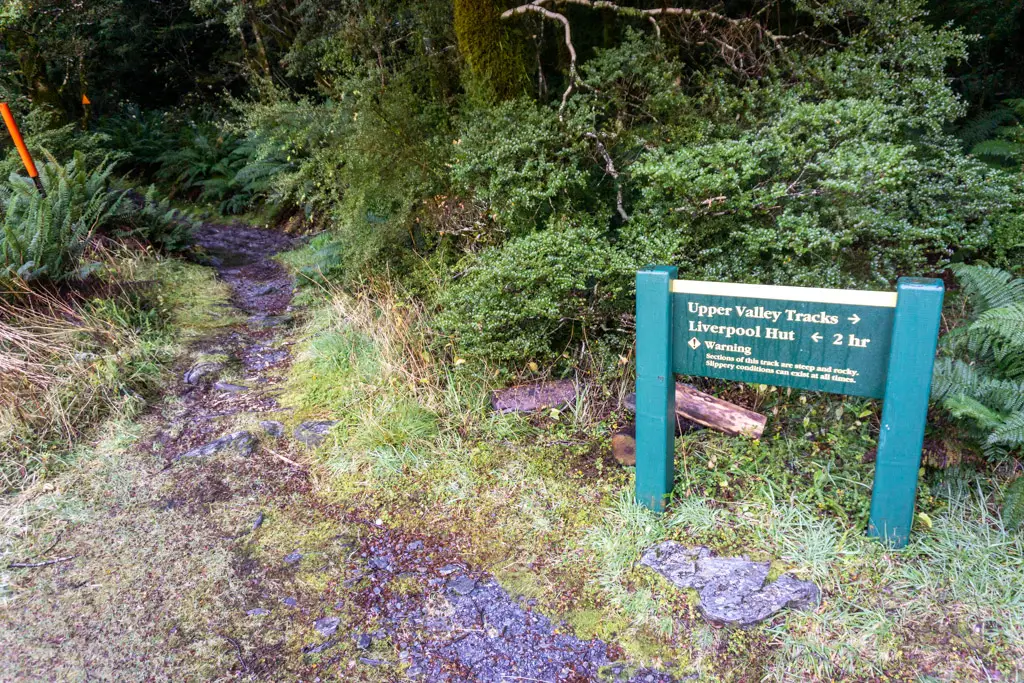
The climb to Liverpool Hut
Well, the first five minutes of the climb to Liverpool Hut tested my determination.
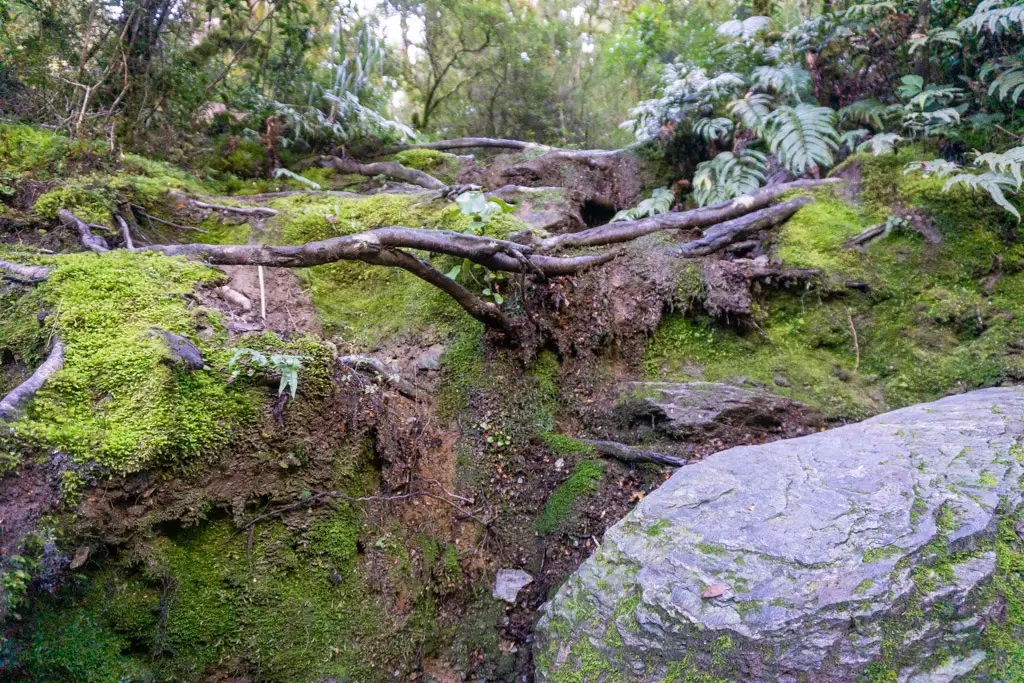
It was extremely steep going, just pulling myself up tree roots really. Once I reached a part where I could safely sit down, I took off my pack, had some water and snacks, and reconsidered my priorities. I’d known that it would be steep. But this was just ridiculous. There was no-one waiting for me at the hut, no-one to encourage me to keep going. I asked myself seriously: would I enjoy the trip more if I just turned around and walked the leisurely two hours back to the safety of Aspiring Hut?
I was slightly tempted, but something in me rebelled and said no. I’d set myself a challenge. I wanted to go somewhere new. And there was only one way to achieve that: keep putting one foot in front of the other. I wasn’t going to be put off just because my muscles were burning. I would turn around if I felt unsafe, but otherwise I just had to keep swimming.
So that’s what I did (the one foot in front of the other part … not the swimming part).
I want to say the track became less steep after that first initial assault. But I can’t tell if it actually did get less steep, or whether I just got used to it. The track reminded me of the climb up French Ridge on the other side of the valley, or even a little of the route up Mt Fox. Except there were a few more exposed rocks to climb up rather than just tree roots. And it was the end of autumn, not the end of summer, so these rocks were slick, which made them a lot harder to climb up.
Often I’d try one approach to a rocky part, reach a point I couldn’t climb up, and have to downclimb and approach the problem a different way. Several times I had to put my poles away. They were more of a liability than a help on those sections. I also didn’t take many photos, just focussing on putting one foot in front of the other.
There was one rocky part that I really didn’t appreciate. It wasn’t the steepest, although it was steep (you may notice this is a recurring theme for this part of the track). But it felt like if you slipped, the runoff was going to be over the edge into the steep gully that Liverpool Creek cascaded down. I hadn’t realised quite how bad it was until I was halfway through; by that stage the safest thing was to keep up my momentum and continue in the same direction rather than try and awkwardly turn around on slippery rock.
Once I’d reached a place I could safely sit down, I reconsidered my options again. I could try to downclimb that part now and then go back to Aspiring Hut or even the carpark for the night. (The reason I’d left so early was to give myself a safety window of daylight if I needed to turn around.) But I was already through that tricky part, and I was going to have to climb it again no matter what I decided. Better to keep going and try it tomorrow when I was well rested.
I’d researched the track to Liverpool Hut more thoroughly than I normally would for a trip with a group. So I knew there was a particularly sketchy part that people described. I’d assumed it would be higher up, but maybe that was it and I was already through the worst?
Oh naive Alice.
I was not through the worst.
The actual part that people had described (a semi-exposed climb up tree roots around a boulder) was a non-event. The tree roots made fantastic hand- and foot-holds, so other than the exposure (which wasn’t extreme at all), it was easy.
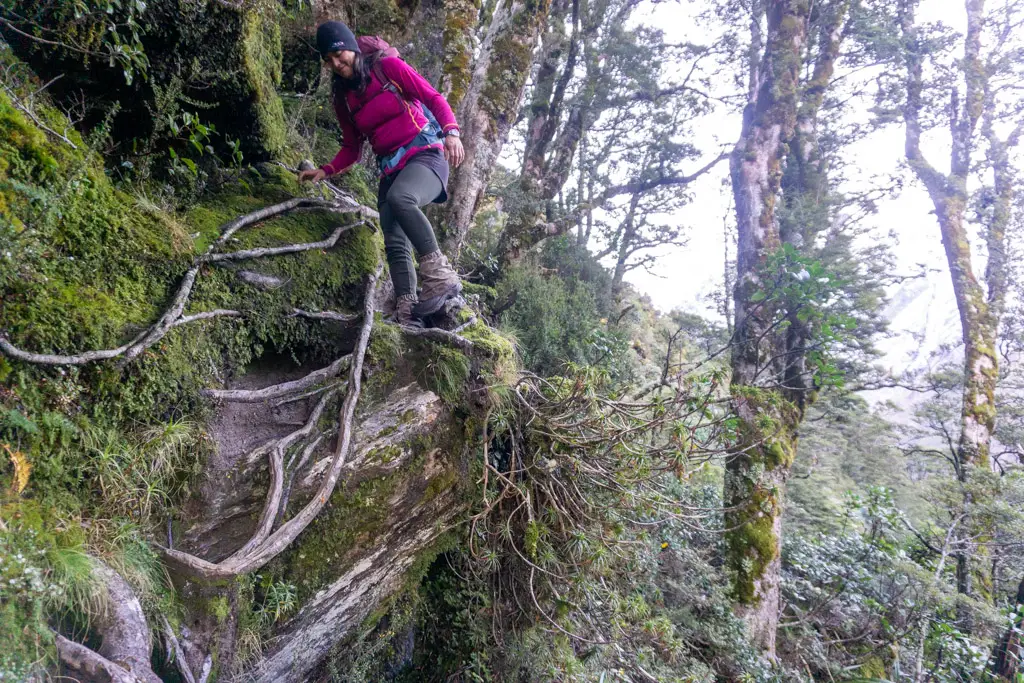
I sat on the top of the boulder for a quick rest and was surprised to hear voices drifting up to me. A couple soon came into view, labouring up the slope beneath me. After exchanging hellos, I let them past, correctly guessing they’d be quicker than me.
After the interesting tree-root climb, we quickly arrived at the bushline. The Matukituki Valley had been teasing me with views through the tree branches, but it was gorgeous in the winter afternoon light with nothing blocking the view.

The track got a bit steeper again above the bushline, with large steps up slippery rocks. Out of cover from the trees, there were icy patches where the sun never reached. They’d probably stay frozen for the rest of the winter. I climbed steadily before finally catching my first view of Liverpool Hut!
And also arriving at the most sketchy part of the entire hike.
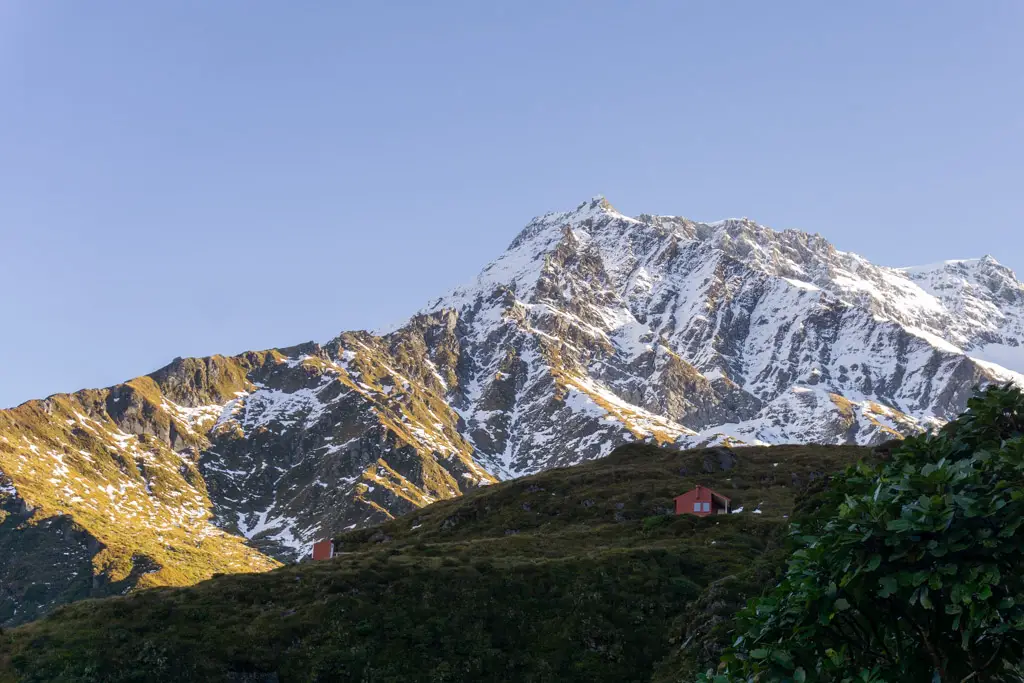
The actual sketchy part
Steep and exposed rock slabs angled towards the downward slope, with hard-packed slippery snow and ice covering them. The Wanaka couple had already climbed through this section, I could hear their voices drifting down from far above.
I put away my poles, zipped up my phone and camera, put on my gloves, tightened my pack straps, and made sure my PLB was within easy reach on my person (not in my bag). I wished I had micro-spikes to put on, although there was just as much icy rock as there was frozen snow.
Step by slow, measured step, I made my way up the rock slabs. I used my hands and arms just as much as my legs, keeping my centre of gravity low. The spaniards (which I would normally curse as they made my legs bleed) were actually helpful here – something to hold onto while I slowly tested which snow sections I could stamp my boots into, and which were frozen solid and too dangerous. Before too long I’d made it through, with no slips or slides at all. Slow and cautious is the way to go.

This was the one part of the hike that made me think I’d been stupid to choose this hike and this time of year to go solo. My friend Penzy told me afterwards that someone she’d known through the Otago University Tramping Club had died on this specific section in winter, slipping and falling 100 m. You can read about that here and here. Even without that knowledge I was already dreading climbing back down this section the next day.
After the scary rock slabs, there was a short uphill section climbing up and over the ridge to give a view of the hut below me (the track climbs up and around the gully, before heading back down to the hut). My poles came in very handy on this downhill section. Before I knew it I was crossing the small stream that feeds into Liverpool Stream, sliding across the ice-covered track and arriving at Liverpool Hut.
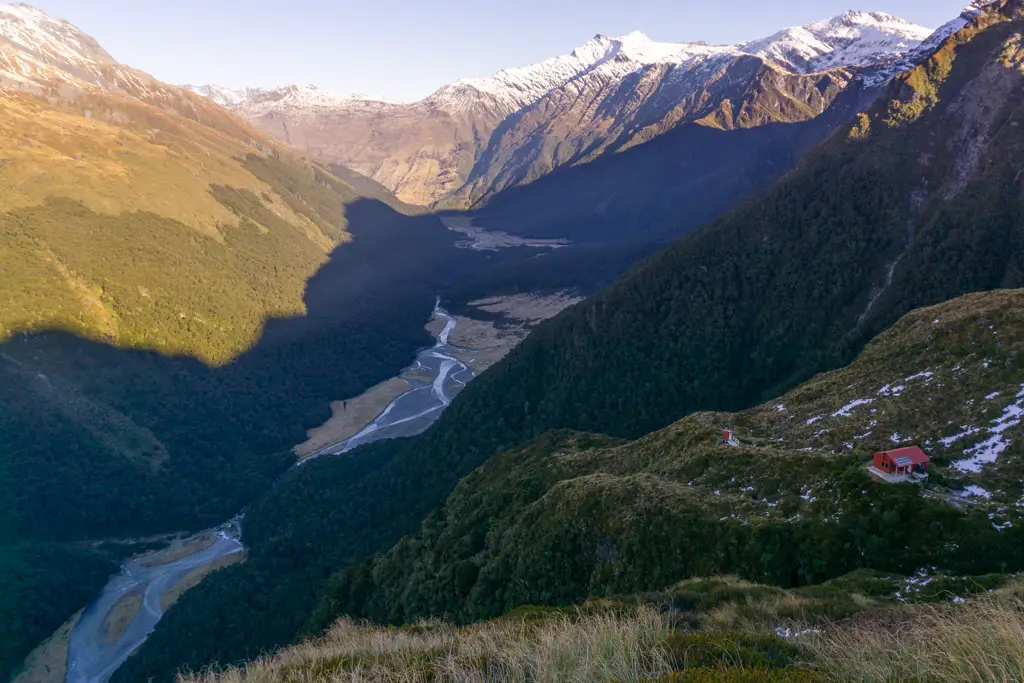
Liverpool Hut
Liverpool Hut was a very welcome sight after the day’s walk and adventures. The Wanaka couple were waiting for me, but hadn’t been able to warm up the hut much without a fireplace. It was almost colder inside the hut than it was outside. I was very thankful my mum had strongly encouraged me to pack a hot chocolate sachet. Liquid sugar had never tasted so good.
I set up my cooking and sleeping gear, put on all my warms layers, and before long another solo hiker, Morgan, had arrived. The four of us had deep discussions about the meaning of life and the merits of everyone’s different food (two very closely related subjects). We also read the OUTC Antics magazine and the DOC Intentions Book cover-to-cover. There were so many comments in the Intentions Book about dreading the downhill, most in the summer. My favourite comment was “I might legitimately die tomorrow”. We all nervously laughed, well, mine was nervous laughter at least.
I was too tired to be motivated to explore more outside of the hut. Plus it was freezing and icy, and I didn’t want to fall over and break something. The view of the mountains and valley from the hut and the long-drop toilet were breath-taking enough, especially as the sun set.
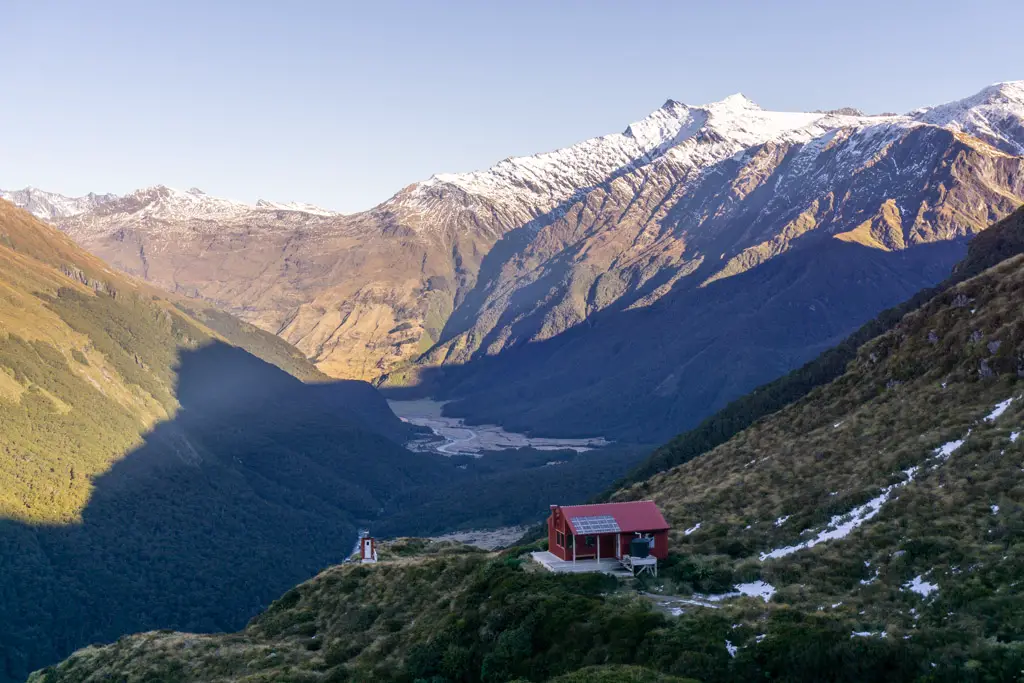
Long after the sun had set and it was starting to get really dark another two hikers arrived – looking extremely relieved to arrive safely at the hut. They didn’t seem super prepared for hiking in the dark, and had obviously left quite late from the carpark. Luckily the moon was ridiculously full and you didn’t really need a headlight to see the track.
After dark, two of their friends arrived. We alternated between scoffing and being worried when we saw their headlights appear over the ridge above the hut, but this couple came equipped with ropes, crampons, ice axes and helmets. They were tackling Mt Barff the next day.
Bedtime comes early to the mountains in winter. I had no trouble falling asleep, and despite the mountaineering couple getting up at 5am and rustling their gear until 7.30am, I had one of the best sleeps I’ve ever had in a hut.
Liverpool Hut: Day 2
The Descent (scarier than the movie)
We woke up to … well firstly the couple at 5.30am (mountaineers are more reliable than alarm clocks), but then later to a clear sky full of stars. I prepped my breakfast and ate while being entertained by several kea trying to skate on the ice outside the hut. Dinner and a show! Unfortunately they’d also left us the gift of a detached hare’s leg in the sink, lovely.


I was nervous about the downhill. Especially the two sketchy parts that had freaked me out on the way up. I brushed my teeth thoroughly, carefully packed my gear into my pack, went to the toilet twice and watched the kea some more. But by that time the sun was up and it was light enough to walk without needing a head torch. The ice and snow on the sketchy section wasn’t going to soften, even if I waited. I couldn’t put it off. It was time to head down.
Morgan, the other solo tramper, was keen to have some company. She said she’d catch me up, of which I had no doubt – she looked much speedier than me (not a difficult feat), so I started off. I reasoned that being solo for the first part of the hike wasn’t going to be any less safe than having Morgan watching me from further back. If something was going to go wrong, a second person wasn’t going to prevent it (although they would be able to get help).
The first part was uphill, back to the top of the ridge, all in full view of the hut. Even though I knew the others in the hut wouldn’t be watching, it still felt like I had an audience. Luckily I didn’t fall flat on my face, even through the several icy sections.
Before too long I was on the other side of the ridge and starting to head down. And then I reached the sketchy icy rock slabs, back in partial view of the hut. This was going to be the hardest part of the entire day. I put my poles away again, strapped everything up tightly, gave up all pretence of dignity, and butt slid all the way down.
Butt sliding (which I believe is the technical term for this technique) meant I had at least three points of contact with the ground at all times. And I could alternate between using my feet and my hands to control my descent. It wasn’t sliding so much as carefully lowering myself down the snow and ice-covered rock slabs.
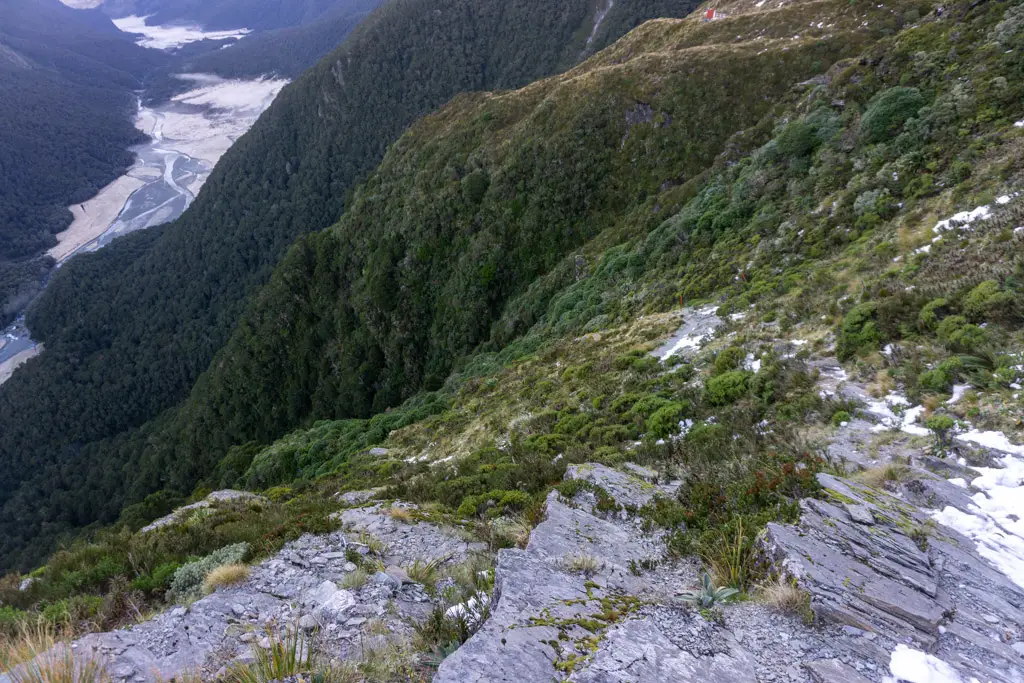
And my soon-to-be-patented butt-sliding technique was successful! In just a few minutes I was down safely, never feeling the least bit freaked out and wondering why I’d been so worried. Sometimes things are a lot harder on the way up than they are on the descent. (But also, sometimes it’s the other way around). Morgan arrived at the top of the rocks slabs just as I was getting my poles out again. She safely negotiated her way down too.
We completed the rest of the downhill together. The tree-root and boulder part was just as easy on the way down as it had been on the way up. And the sketchy part about halfway down that I hadn’t enjoyed on the way up? Also a non-event. Morgan and I chatted away, and before I knew it we were already half-jumping down the steep part right before the valley floor.
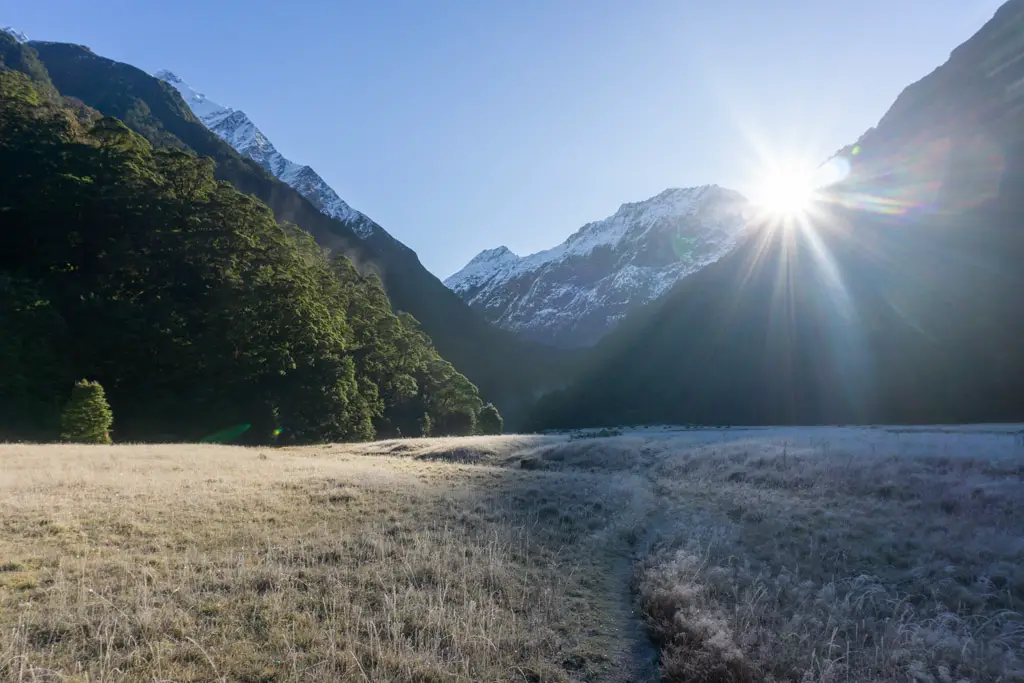
The walk out
Morgan and I walked together all the way to Aspiring Hut, through the frosty tussock meadows and golden forest. At Aspiring Hut we had an early lunch and Morgan generously offered me another hot chocolate. (Memo to self: hot chocolates in the winter are just as important as a PLB). Morgan offered to keep walking with me all the way out to the carpark, but I was keen to be by myself for a bit again and savour my first solo trip. Plus I knew she’d be much speedier without me.
The last two hours of the walk out were very uneventful, other than meeting so many people walking the other way. This section also went by very quickly and it felt like I’d only been walking for half an hour when I reached the last little uphill towards the Rob Roy swing-bridge.
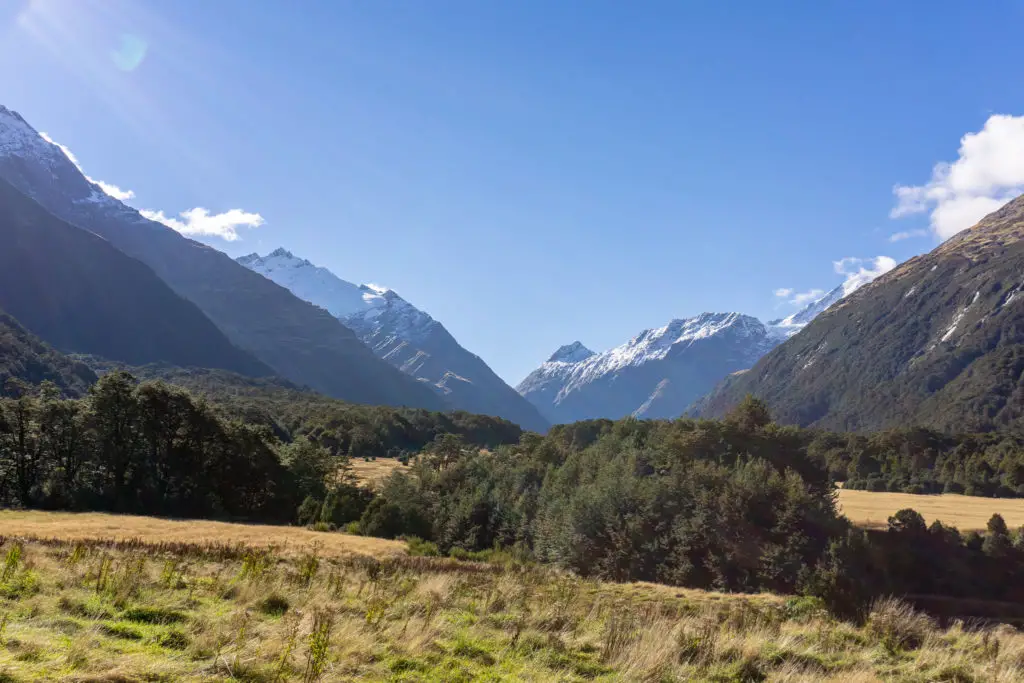
At the swing-bridge, only 20 minutes from the carpark, I saw an older couple on bikes, holding up a blinking PLB. They weren’t the ones who’d had the accident. And it wasn’t even their PLB! Apparently another person had witnessed someone falling on icy rocks halfway up the Rob Roy Glacier track. She’d either dislocated her shoulder or fractured her collar bone. The witness had then rushed down the track until he came upon someone with a PLB and set it off. He’d then climbed up the farmland side of the hill, trying to get cell service (which was never going to happen, but good on him for trying), while the owner of the PLB drove out to contact SAR (and probably also to reassure their emergency contacts that the PLB hadn’t been set off for them).
It sounded like the injured person was being well taken care of, help had already been sought, and there was still plenty of daylight, so there wasn’t much for me to add. I continued on towards the carpark, being ultra conscious of the ice. I didn’t want to make myself late for my check-in with my own emergency contacts and have them call SAR because they thought I was lost or injured.
It did hammer home that even on easier tracks things can go wrong so easily. And that you should always, always carry a PLB no matter how easy or short the walk. I wondered how much our expectations affect the risks we choose to undertake. Was I more careful on a track that I considered hazardous, compared to this person who was just on an easy day walk? I definitely went slower on a lot of sections than if I was on a day walk, or even on a harder hike but not solo. Or was it just luck that I hadn’t slipped at any point in the walk and injured myself? All it would take would be a moment of inattention at the wrong time. Maybe it was a combination of both carefulness and luck?
I reached my car without incident, and changed into clean clothes and loose shoes (the best feeling!). I drove out to Glendhu Bay and text my emergency contacts letting them know I was out safe. Then it was just a matter of driving all the way back to Invercargill for work the next day – potentially the most dangerous part of the whole weekend!

So what did I learn from my first solo hike?
Well, I learnt that deciding to hike solo for the first time in winter is a stupid idea. Especially if you choose a challenging tramp above the treeline that you’ve never done before. Hiking in the summer months on easier terrain, or terrain I’m more familiar with, would definitely be safer.

I’m also aware that according to the Mountain Safety Council’s A Walk in the Park report almost half of tramping fatalities occurred with someone who was on their own. Being a part of a group often (but not always) aids safe decision-making.
But otherwise I learnt it was something I actually enjoyed. I liked being able to go at exactly my own pace and stop when I wanted to, for as long as I wanted. And I liked the challenge of only relying on myself.
Will I do it again? Probably. I still prefer to tramp with others, and I know that it’s safer according to the statistics. But having no-one to go with will no longer stop me if there’s a fine weather weekend and mountains to visit. And that seems like a win to me!
Should you choose French Ridge Hut or Liverpool Hut?
It’s hard for me to pick my favourite trip from French Ridge and Liverpool. Mainly because I completed them both under such different circumstances – one with the perceived safety of my Dad in warmer conditions, and the other one hiking solo at the start of winter.
Winner: Views
The award for best views would have to go to Liverpool Hut. The views from the hut back down the Matukituki Valley and across to Tititea / Mt Aspiring are absolutely insane. Going later in the season (which I wouldn’t recommend without appropriate experience), meant the snow-covered mountains added more drama to the views.

Winner: Overall Experience
But my overall winner would be French Ridge Hut. The track up is a harder grunt in terms of fitness, but less so in terms of nerves / vertigo compared to Liverpool Hut. And the views are gorgeous there too. You really feel like you’re up properly in the mountains.
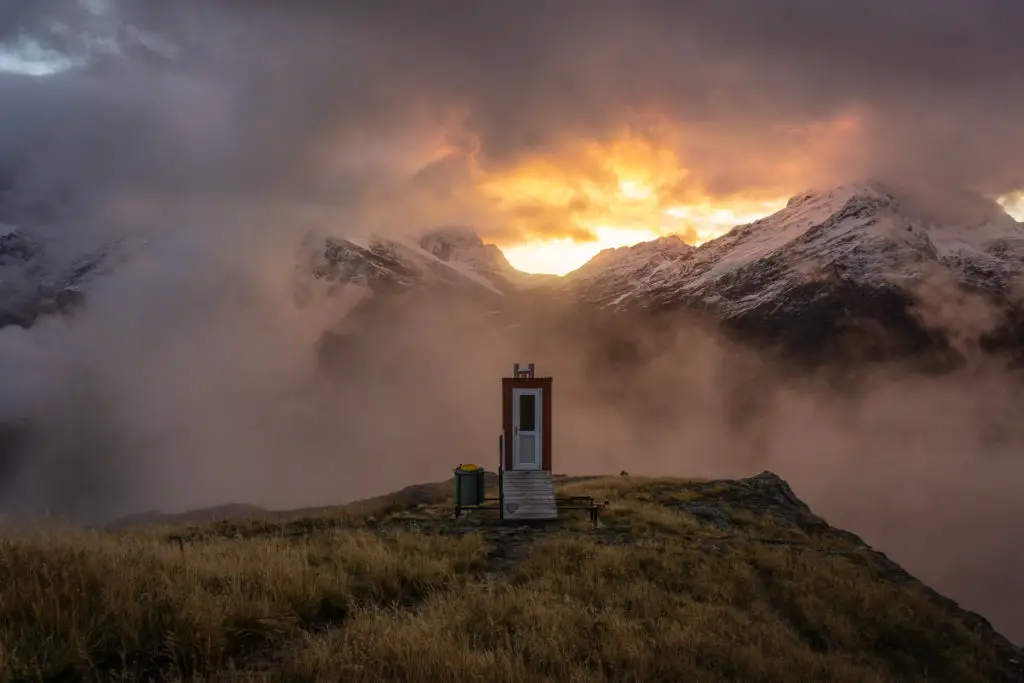
Which would you choose? Would you hike solo?
Safety
As always, please stay safe when you’re out exploring. Follow the Outdoor Safety Code:
- Choose the right trip for you (read my article, talk to DOC, look at Topomaps, read other blogs!)
- Understand the weather (this would be an extremely dangerous hike in adverse conditions)
- Pack warm clothes and extra food (including windproof and warm layers, regardless of how nice the day is when you set out. You check out my post on what to taking tramping here)
- Share your plans and take ways to get help (have an emergency beacon on your person)
- Take care of yourself and each other
This is a trip into alpine areas. Do not underestimate the conditions and stay within your level of experience and comfort. Weather conditions will change your trip drastically. Ensure you know the weather forecast and adjust your plans accordingly before setting out.
If you’re not feeling super confident then you can always get in touch with me here on the blog or on my Instagram. Or take a look at my Tramping 101 series which includes this post about how to stay safe in the outdoors.
Stay safe and get outside!
Where to next?
LET ME KNOW WHAT YOU THINK! LEAVE ME A COMMENT OR MESSAGE ME OVER ON MY INSTAGRAM.
I love hearing from readers and helping them plan their own adventures!

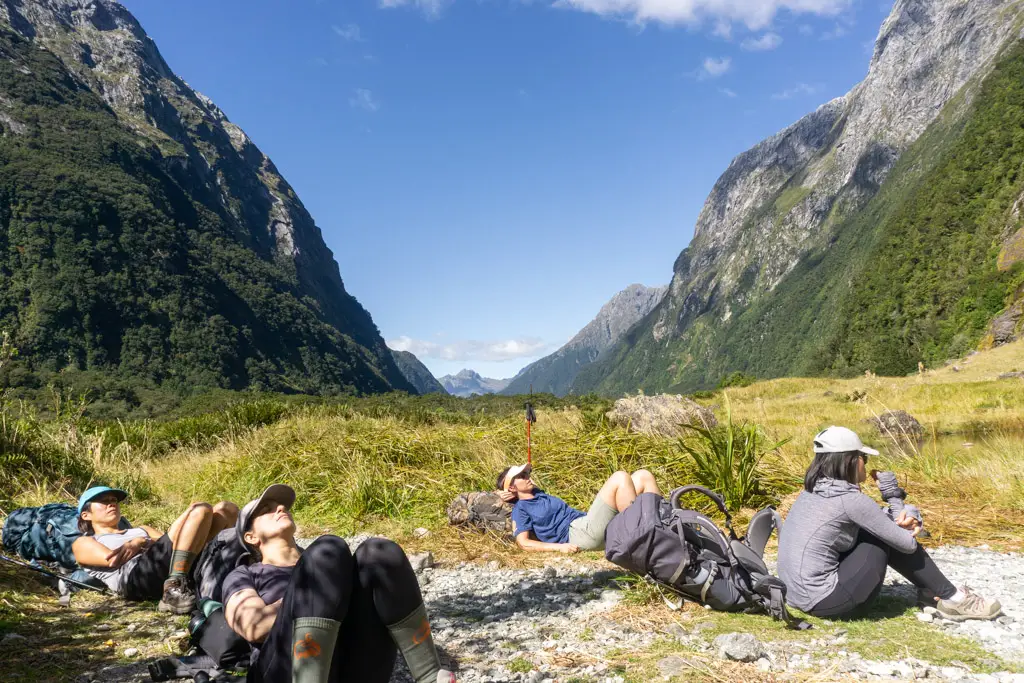

I like your account of a trip that I have done about four times solo. You are right to take care on the exposed slabs.
Thanks Rod! Yes, probably not the smartest first solo overnight tramp for me to choose at the end of autumn haha. But it was a great experience! And lots of learning. I’d love to go back in summer with longer daylight hours so I get more time up at the hut admiring the views. Any other huts or trips you’d recommend?